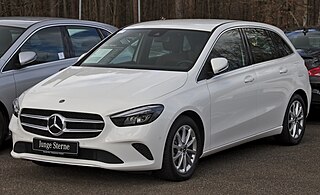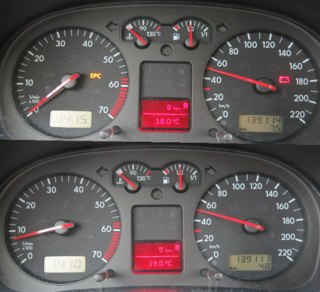
A clutch is a mechanical device that allows the output shaft to be disconnected from the rotating input shaft. The clutch's input shaft is typically attached to a motor, while the clutch's output shaft is connected to the mechanism that does the work.

A hybrid vehicle is one that uses two or more distinct types of power, such as submarines that use diesel when surfaced and batteries when submerged. Other means to store energy include pressurized fluid in hydraulic hybrids.

A vehicle start-stop system or stop-start system automatically shuts down and restarts the internal combustion engine to reduce the amount of time the engine spends idling, thereby reducing fuel consumption and emissions. This is most advantageous for vehicles which spend significant amounts of time waiting at traffic lights or frequently come to a stop in traffic jams. Start-stop technology may become more common with more stringent government fuel economy and emissions regulations. This feature is present in hybrid electric vehicles, but has also appeared in vehicles which lack a hybrid electric powertrain. For non-electric vehicles fuel economy gains from this technology are typically in the range of 3–10%, potentially as high as 12%. In the United States, idling wastes approximately 14.8 billion liters of gasoline per year.

Overdrive is the operation of an automobile cruising at sustained speed with reduced engine revolutions per minute (RPM), leading to better fuel consumption, lower noise, and lower wear. The term is ambiguous. The most fundamental meaning is that of an overall gear ratio between engine and wheels, such that the car is over-geared, and cannot reach its potential top speed, i.e. the car could travel faster if it were in a lower gear, with the engine turning at higher RPM.

The Mercedes-Benz B-Class is a subcompact executive car manufactured and marketed by Mercedes-Benz since 2005. Based on the A-Class with larger dimensions, the European New Car Assessment Programme classifies it as a small MPV.

A direct-shift gearbox is an electronically-controlled, dual-clutch, multiple-shaft, automatic gearbox, in either a transaxle or traditional transmission layout, with automated clutch operation, and with fully-automatic or semi-manual gear selection. The first dual-clutch transmissions were derived from Porsche in-house development for the Porsche 962 in the 1980s.
A driving cycle is a series of data points representing the speed of a vehicle versus time.

The European emission standards are vehicle emission standards for pollution from the use of new land surface vehicles sold in the European Union and European Economic Area member states and the United Kingdom, and ships in EU waters. The standards are defined in a series of European Union directives staging the progressive introduction of increasingly stringent standards.

The World Forum for Harmonization of Vehicle Regulations is a working party (WP.29) of the Inland Transport Committee (ITC) of the United Nations Economic Commission for Europe (UNECE). Its responsibility is to manage the multilateral Agreements signed in 1958, 1997 and 1998 concerning the technical prescriptions for the construction, approval of wheeled vehicles as well as their Periodic Technical Inspection and, to operate within the framework of these three Agreements to develop and amend UN Regulations, UN Global Technical Regulations and UN Rules, kind of vehicle regulation.
A transmission control unit (TCU), also known as a transmission control module (TCM), or a gearbox control unit (GCU), is a type of automotive ECU that is used to control electronic automatic transmissions. Similar systems are used in conjunction with various semi-automatic transmissions, purely for clutch automation and actuation. A TCU in a modern automatic transmission generally uses sensors from the vehicle, as well as data provided by the engine control unit (ECU), to calculate how and when to change gears in the vehicle for optimum performance, fuel economy and shift quality.

The fuel economy of an automobile relates to the distance traveled by a vehicle and the amount of fuel consumed. Consumption can be expressed in terms of the volume of fuel to travel a distance, or the distance traveled per unit volume of fuel consumed. Since fuel consumption of vehicles is a significant factor in air pollution, and since the importation of motor fuel can be a large part of a nation's foreign trade, many countries impose requirements for fuel economy. Different methods are used to approximate the actual performance of the vehicle. The energy in fuel is required to overcome various losses encountered while propelling the vehicle, and in providing power to vehicle systems such as ignition or air conditioning. Various strategies can be employed to reduce losses at each of the conversions between the chemical energy in the fuel and the kinetic energy of the vehicle. Driver behavior can affect fuel economy; maneuvers such as sudden acceleration and heavy braking waste energy.

The Smart Forfour is a city car (A-segment) marketed by Smart over two generations. The first generation was marketed in Europe from 2004 to 2006 with a front-engine configuration, sharing its platform with the Mitsubishi Colt. The second generation was marketed in Europe from 2014 after an eight-year hiatus, using rear-engine or rear electric motor configurations. It is based on the third-generation Renault Twingo, which also forms a basis for the third-generation Smart Fortwo. A battery electric version was marketed as the EQ Forfour beginning in 2018.

Energy-efficient driving techniques are used by drivers who wish to reduce their fuel consumption, and thus maximize fuel efficiency. The use of these techniques is called "hypermiling".

The BMW i8 is a plug-in hybrid sports car developed by BMW. The i8 was part of BMW's electrified fleet and was marketed under the BMW i sub-brand. The production version of the BMW i8 was unveiled at the 2013 Frankfurt Motor Show and was released in Germany in June 2014. Deliveries to retail customers in the U.S. began in August 2014. A roadster variant was launched in May 2018. Production ended in June 2020.
The EPA Federal Test Procedure, commonly known as FTP-75 for the city driving cycle, are a series of tests defined by the US Environmental Protection Agency (EPA) to measure tailpipe emissions and fuel economy of passenger cars.
The Worldwide harmonized Light vehicles Test Procedure (WLTP) is a global standard for determining the levels of pollutants, CO2 emissions and fuel consumption of traditional and hybrid cars, as well as the range of fully electric vehicles.

The Volkswagen Golf (Mk7) is a small family car (C-segment) manufactured by German automobile manufacturer Volkswagen. It is the seventh generation of the Golf and the successor to the Golf Mk6. It was introduced at Berlin on 4 September 2012, before a public launch at the 2012 Paris Motor Show. Sales in Europe began with the model in November 2012.

The Volkswagen Passat (B8) is a mid-size car/large family car manufactured by Volkswagen that is available in a 4-door saloon and a 5-door estate body style sold as "Variant" in some markets. It was first introduced at the Volkswagen Design Center Potsdam on 3 July 2014. The B8 is the eighth-generation model in the Volkswagen Passat series and the first passenger vehicle of Volkswagen Group to be based on a stretched version of the MQB platform. The Passat Variant shares its platform with the Tiguan.
The World Motorcycle Test Cycle (WMTC) is a system of driving cycles used to measure fuel consumption and emissions in motorcycles. The methods are stipulated as part of the Global Technical Regulation established under the United Nations’ World Forum for Harmonisation of Vehicle Regulations, also known as WP.29.

Gliding is an energy-efficient driving mode achieved by turning off the internal combustion engine while the vehicle is still moving in order to save fuel. This is differentiated from coasting, which means running the vehicle in idle mode by disengaging the engine from the wheels, either by disengaging the clutch or setting the transmission or gearbox to neutral position. Gliding and coasting use the accelerated kinetic energy reserve stored in the vehicles mass, i.e. inertia, to keep the vehicle moving. This energy, however, is being lost due to forces that resist movement, such as air-drag, rolling resistance and gravity. The functionality, being an integral concept of hybrid electric vehicles, is performed automatically by the engine controller. For vehicles with a conventional internal combustion engine, coasting can be performed manually; gliding requires having a gear box. Manual gliding or coasting is illegal in some states. An extra button to stop the engine was shown in 1979 on International Motor Show Germany, but never became a feature in mass production of any vehicle. In 1980 research was made on the IRVW II. A so-called eClutch uses an actuator to disengage the clutch when the driver releases the accelerator.















